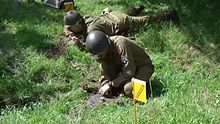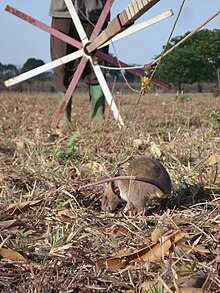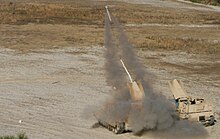Mine clearance

As a demining (rare demining ) of the process is referred to, land or sea mines from an area to be removed. A basic distinction is made between two methods. On the one hand, the removal in peacetime (civil mine clearance), on the other hand, mine clearing as part of a military operation.
Problem
Laying mines is relatively easy and inexpensive, but clearing them is all the more difficult and costly. In land warfare today, particularly asymmetrical conflicts such as civil wars leave dangerous minefields behind , because these are seldom mapped when they are laid, are used over a large area and are often used in areas of civil life.
When laying mines, it is common to mix different types of mines, so that z. B. mine clearance tanks can not safely drive into a field of anti-personnel mines and in return human deminers can not safely defuse anti-tank mines. Anti-tank mines with pressure detonators are normally not triggered by the weight of a person, but safety mines, safety devices and booby traps make them more difficult to clear.
Military mine clearing
In the combat zone, mine clearance is carried out in order to break through minefields quickly so that a safe path is available for the troops or the ships. Speed is of great importance in this case for two reasons. On the one hand, for tactical reasons, on the other hand, there is a danger of enemy fire when breaking through the minefield. Due to the great importance of speed, it is accepted that the clearance is not completely complete and that there may still be some undiscovered mines. This also means that the risk of people and material being lost is accepted. The methods of military mine clearance are primarily aimed at effectiveness, damage in the affected area, e.g. B. by soil erosion are sometimes significant. The mine clearance tank Keiler mills z. B. an alley with 4.70 m wide and 25 cm deep through the area. Away from this alley there may still be mines that have not been triggered and that continue to pose a threat.
Civil mine clearing
Demining for the civilian population has a completely different primary goal than military demining. In times of peace, mines are removed in a thorough and time-consuming process so that the area can be used normally again. It is very important that the eviction in this case be very thorough. Even if only a few mines go undetected, it is very dangerous. If people move freely in an area because they assume that it is mine-free, they can be injured or even killed by detonations.
The term “humanitarian mine clearance”, which was wrongly naturalized from the English for civil mine clearance, is mostly misunderstood as manual mine clearance “by human”. In fact, manual demining continues to be the predominant use of civilian demining.
Mechanical clearing devices are also used specifically to reduce suspected areas ( English “area reduction” ). These mechanical systems are only conditionally suitable for civil mine clearing. In the engine-mechanical clearing process, not all mines are rendered harmless, but some are left damaged in an unsafe condition. Use in forests, difficult terrain and built-up areas is not possible. Most systems dig up the top layer of the earth. This destroys all infrastructure (e.g. roads) as well as existing vegetation.
It is estimated that an annual output of US $ 1 billion would be enough to demine the entire world. In 2000, however, only about 400 million were donated for this purpose. It takes one to two million US $ to clear a square kilometer of mines. Often times, demining is a necessary condition for other humanitarian programs to begin. Several international efforts have been made to test and evaluate existing and new demining technologies; especially in the EU , the United States , Canada and Japan .
Officially, before October 1, 2001, based on the "International Standards for Humanitarian Mine Clearance Operations" 1997 standard, a clearance rate for hand deminers of 99.6% up to a depth of 200 mm was sufficient. As the total number of mines laid is generally unknown, an effective control of this clearance rate is rarely possible. Since then, the "International Mine Action Standards" (IMAS), Edition 2, have described the goal of clearing all mines or rendering them harmless.
The only way to comply with the International Mine Action Standards is usually by manually tracing and removing mines. However, this is relatively slow, expensive and dangerous. New technologies may create safer alternatives.
Mine detection
Manually
The most widely used method is manual search with metal detectors with a mine probe . In a first step, an area is searched with a metal detector that is sensitive enough to detect the largest possible number of mines. It is accepted that there are around a thousand false reports for one mine. Areas showing metal are carefully examined to determine if there is a mine. The mine search may not continue until the metallic object that triggered the detector message has been found. However, plastic mines that do not contain metal cannot be detected using this method.
Animals
Animals are also increasingly used. There are specially trained mine detection dogs (specially trained explosives detection dogs ), which can detect explosives such as TNT , which are contained in land mines. Mine detection dogs are used in some countries. From Apopo are also specifically to the smell of explosives trained giant pouched rats used.
The US Navy uses sea lions and dolphins , among others , to track down sea mines.
Mine clearance
See battle for bans
Manually
After a mine has been located, it is defused by hand or blown up on site. To defuse, the soil is carefully removed to expose the mine. The defusing is then usually done by hand, in that the defuser renders the detonator harmless. The terrain can be prepared mechanically for the hand deminers, with the shrubbery, bushes and grasses above the ground being mowed by “vegetation cutters”. In the case of mines that are not safe to handle or mines with anti-lift protection, they are destroyed by detonating them at the location with a blow charge .
Mechanical clearance

The actual contrast to manual mine clearance is the “fully mechanical mine clearance”, in which humans no longer have to work directly at the point of greatest danger, but have the dangerous work carried out by machines.
Specially developed machines effectively combine mine detection and mine removal in one process. In the past, the machines were used for both humanitarian missions and military cleanup. These machines can be used to comb land suspected of having mines or as an additional safety measure after the area has already been cleared by another method such as dogs.
These machines are specially developed. The driver is behind a massive protective shield, or the machine is controlled remotely. This machine is then combed through the minefield. The machine itself is built so robustly that it can withstand any detonations without major damage.
A distinction is made between the following evacuation methods:
- Plow system
- One method is to mount mine plows on the front of traditional tanks / other vehicles (such as the US M1 Abrams- based Assault Breacher Vehicle (ABV)). These vehicles do not work perfectly, however, because some mines do not detonate and their mechanics are not damaged or only slightly damaged, which is why manual clearing is still necessary before a site is cleared.
- Flail system
- Pieces of chain are attached to a rotatable cylinder. The cylinder spins quickly, the chains lash against the ground and detonate the mines. There is a risk of partial damage and mines being pushed into greater depths. With civil mine clearance, a flail cutter can only prepare the clearance by hand. There are land mines that cannot be triggered with a flail cutter. Examples of flail cutters: Keiler , Digger D2.
- Roller system
- Heavy mine rollers are attached in front of the vehicle, which are supposed to trigger mines lying in the lane.
- Tiller
- The ground is dug up to a certain depth (20 cm – 1 m) and crushed; Mines are regularly detonated, duds and obstacles (bushes, roots, stones) are crushed. In contrast to the plow, the soil is not only plowed through at several points, but also processed in the entire volume.
- Magnet system
- Often used in conjunction with mine rollers or mine plows. Electromagnets placed in front of the vehicle generate a field that is intended to trigger the magneto prematurely.
It is also conceivable to use a remote-controlled robot to defuse it, but this is not realistic in poor countries. There are plans to use many small, cheap, autonomous robots to detonate the mines. However, this project has not yet been put into practice and would continue to require manual clearance.
Massoud Hassani designed Mine Kafon in 2012 , a ball made of bamboo spikes with spring-loaded plates as feet. The structure with a diameter of 2 m rolls on the plain, driven by the wind alone, while a GPS data logger in the core registers the swept track and communicates it to the outside via GPRS.
Pyrotechnic cleaning methods
A method developed before the First World War is the Bangalore stick bomb . The blast from the explosion ignites neighboring mines, creating a narrow, mine-free alley.
The US Army uses the so-called MICLIC system, the Mine Clearing Line Charge, the Russian Army the UR-77 and the British Army the Python Minefield Breaching System , in which a detonating cord is shot into the minefield with a missile and then an alley blows up.
However, there have been land mines for a long time that are insensitive to impulse loads, such as the types VS-MK2 or MAUS produced in Italy or the PMA-3 produced in the former Yugoslavia .
More recent developments use the powerful explosive effect of aerosol bombs , which are shot with rockets into the area to be cleared.
Other clearing methods

The use of animals (e.g. sheep) as mine triggers was also practiced for mine clearance in some countries, for example on the British Falkland Islands or the war zones in the former Yugoslavia . Occasionally people are forced to commit suicide to trigger mines, such as B. German prisoners of war in Jutland, Denmark . As a result, the Iranian volunteer militia Basitschi-e Mostasafan became famous in the Iran-Iraq war .
- Refills can be fixed with a method for expanding foams using multi-chamber plastic containers. As a result, further handling of the mines can be carried out safely, since the mine is effectively prevented from being triggered by blocking the release mechanisms.
- Remote-ignited combustion of the explosive. If possible, it is better to burn the explosive without causing a detonation. The TNT present in the mines is allowed to react with diethylenetriamine to generate heat. The compound that results from this reaction can now burn without detonation. It has been reported that this amine is hypergolic with TNT, Tetryl , Composition B , and other TNT-based explosives . However, it does not react in this form with explosives based on hexogen or nitropenta . Other nitrogen-containing organic ligands (e.g., pyridine , diethylamine, and pyrrole ) are known to be hypergolic with TNT.
- The mine is set on fire while preventing a large detonation. This can be done by cutting holes in the mine without causing the contents to explode.
Personal protective equipment
People who carry out mine clearance are equipped with personal protective equipment. This consists of helmets, visors, armored gloves and a bulletproof vest. This special equipment provides a high level of protection against anti-personnel mines.
Detection methods in development
Advanced electromagnetic methods
Ground-breaking radar
Conventional metal detectors are based on electromagnetic frequencies in the range from 10 to 100 kHz, which are not sensitive enough to detect wooden or plastic mines. The only part of such mines that can be detected with conventional detectors is the detonator, as it contains small amounts of metal. Significantly higher-frequency signals (in the 1 GHz range) are used in ground-breaking radar . These signals are sensitive enough to be able to detect non-metallic parts of the mine. However, this technique is so sensitive that it even works on tree roots and stones. Thus, the demarcation between mines and harmless objects is very difficult.
Double sensor
A hybrid sensor, which includes ground-covering radar as well as the metal detector, is being developed by some companies and research organizations.
Infrared
Drop mines, mainly butterfly mines, remain on the surface. Since they usually hardly contain any metal, they cannot be found conventionally with a metal detector. One approach to find these mines anyway is based on infrared radiation. The mines heat and cool differently than the rest of the area. These differences in heat can be seen after sunrise and after sunset with a sensitive infrared camera from the air.
Biological discovery
Honey bees
Recent studies from the University of Montana found that honeybees, with minimal training, can be used to detect landmines with a higher detection rate than dogs or rats.
plants

Under certain environmental conditions and in autumn, many plants show a clearly recognizable red color of the leaves, which is caused by the formation of anthocyanins . The genes responsible for synthesizing these dyes are inactive for most of the year. A Danish biotech company has genetically modified plants of the thale cress ( Arabidopsis thaliana ) in such a way that this red color is caused by the gas nitrogen dioxide (NO 2 ) if the roots have been exposed to it for three to five weeks. NO 2 is created, among other things, as a breakdown product of explosives such as TNT . The working group is developing a method to be able to distribute the seeds quickly and safely with an atomizer. To prevent unintentional spreading, an important growth gene has been switched off so that the plant can only thrive in the presence of a special fertilizer. Use in dry climates or in the presence of other fast-growing plants (overgrowth) is not possible. Another problem with this detection method can be the natural presence of NO 2 in the soil.
bacteria
A bacterium has been genetically engineered to fluoresce under ultraviolet light when the bacterium is exposed to TNT. In tests in which such bacteria were distributed over simulated minefields, the mines were successfully located. In practice, large areas of the most varied of soil conditions could be examined quickly. However, these bacteria can also mark clean surfaces as mined. Furthermore, these bacteria are not visible in normal daylight. The problem also arises here that only the TNT is displayed. Other explosives, including those used, are not displayed with this method.
Nuclear physics discovery
Most of the explosives used in landmines are high in nitrogen compared to other materials . With the help of a neutron source, it is possible to find nitrogen accumulations also under the earth's surface by means of the nuclear reaction 14 N (n, γ) 15 N, since the isotope 15 N that is formed emits easily measurable gamma radiation .
Acoustic discovery
It is possible to detect landmines by directing sound waves at the mine area, which vibrate the landmines. With a laser, the ground can now be examined for vibrations and the mines can be found. Such devices are z. B. at the University of Mississippi and at the Massachusetts Institute of Technology .
literature
- Christian Litz: Mine dreamer. In: brand eins . Issue 5, 2003 ( brandeins.de ; mine clearance in Germany).
Individual evidence
- ↑ As of February 2007.
- ↑ Landmines - Some Common Myths. In: mech.uwa.edu.au. Retrieved January 6, 2013 (Australian English). .
- ↑ International Test and Evaluation Program for Humanitarian Demining (ITEP) ( Memento of March 10, 2009 in the Internet Archive ).
- ↑ Serac Unit -: Metal detector Trials ( Memento June 4, 2009 in the Internet Archive ).
- ↑ Clearance rate for 1997 ( memento of October 27, 2005 in the Internet Archive ) (English).
- ↑ Current clearance rate ( memento of September 24, 2009 in the Internet Archive ) (PDF) (English).
- ↑ International Mine Action Standards (IMAS) project ( Memento from December 12, 2006 in the Internet Archive ).
- ↑ a b What is demining? In: mech.uwa.edu.au .
- ↑ Metal Detector Handbook ( Memento of March 27, 2009 in the Internet Archive ) (PDF).
- ↑ Mine detection dog in action . Demining Research website. University of Western Australia. Retrieved March 28, 2000.
- ↑ Mine search with rats.
- ^ Mine Hunting Systems of the US Navy Marine Mammal Program ( Memento April 14, 2009 in the Internet Archive ).
- ↑ Mine clearance with a tiller , accessed on November 15, 2011.
- ↑ The Mine kafon: Massoud Hassani at TEDxUtrecht. YouTube video dated December 5, 2012.
- ↑ DPMA patent no. 102 04 784.
- ^ Humanitarian-demining.org ( Memento of April 8, 2006 in the Internet Archive ).
- ^ Humanitarian-demining.org ( Memento of March 10, 2005 in the Internet Archive ).
- ^ Electrochemical Machining for UXO Neutralization .
- ↑ Christoph Seidler: Researchers take up the fight against landmines with drones. In: Der Spiegel . 17th December 2018.
- ↑ Jerry J. Bromenshenk et al. a .: Bees used in Area Reduction and Mine Detection. In: Journal of Mine Action. Edition 7.3; accessed December 2003.
- ↑ Page no longer available , search in web archives: Presentation of Aresa Biotech at the NDRF Summer Conference 2007 (PDF; no mementos) In: ndrf.dk, accessed on January 4, 2011 (English).
- ↑ Biological mine search. Austrian Armed Forces; Retrieved Jan. 4, 2011.
- ↑ RS Burlage, M. Hunt, J. DiBenedetto, M. Maston: Bioreporter Bacteria For The Detection Of Unexploded Ordnance. Extract from the Demining Research website.
- ↑ M. Cinausero, M. Lunardon, G. Nebbia, S. Pesente, G. Viesti, V. Filippini: Development of a thermal neutron sensor for Humanitarian Demining. In: Applied Radiation and Isotopes . Volume 61, Issue 1, 2004, pp. 59-66, PMID 15145439 .
- ↑ ieeexplore.ieee.org (PDF).
- ↑ newscientisttech.com .









